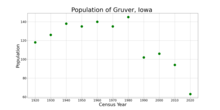Gruver, Iowa
Gruver, Iowa | ||
|---|---|---|
FIPS code 19-33240 | | |
| GNIS feature ID | 0457174 | |
Gruver is a city in
History
Gruver was laid out in 1899. The town was called Luzon until 1900, when it the name was changed to Gruver.[3]
Geography
Gruver is located at 43°23′35″N 94°42′17″W / 43.39306°N 94.70472°W (43.393113, -94.704719).[4]
According to the United States Census Bureau, the city has a total area of 0.13 square miles (0.34 km2), all land.[5]
Demographics
| Year | Pop. | ±% |
|---|---|---|
| 1920 | 118 | — |
| 1930 | 126 | +6.8% |
| 1940 | 138 | +9.5% |
| 1950 | 135 | −2.2% |
| 1960 | 140 | +3.7% |
| 1970 | 135 | −3.6% |
| 1980 | 145 | +7.4% |
| 1990 | 102 | −29.7% |
| 2000 | 106 | +3.9% |
| 2010 | 94 | −11.3% |
| 2020 | 63 | −33.0% |
| Source:"U.S. Census website". United States Census Bureau. Retrieved March 28, 2020. and Iowa Data Center Source: | ||

2010 census
As of the
There were 38 households, of which 31.6% had children under the age of 18 living with them, 50.0% were married couples living together, 5.3% had a female householder with no husband present, 7.9% had a male householder with no wife present, and 36.8% were non-families. 31.6% of all households were made up of individuals, and 21.1% had someone living alone who was 65 years of age or older. The average household size was 2.34 and the average family size was 3.00.
The median age in the city was 32.5 years. 28.7% of residents were under the age of 18; 11.6% were between the ages of 18 and 24; 17% were from 25 to 44; 27.6% were from 45 to 64; and 14.9% were 65 years of age or older. The gender makeup of the city was 55.3% male and 44.7% female.
2000 census
As of the
There were 42 households, out of which 28.6% had children under the age of 18 living with them, 69.0% were married couples living together, 7.1% had a female householder with no husband present, and 21.4% were non-families. 14.3% of all households were made up of individuals, and 7.1% had someone living alone who was 65 years of age or older. The average household size was 2.52 and the average family size was 2.76.
In the city, the population was spread out, with 21.7% under the age of 18, 9.4% from 18 to 24, 24.5% from 25 to 44, 29.2% from 45 to 64, and 15.1% who were 65 years of age or older. The median age was 38 years. For every 100 females, there were 100.0 males. For every 100 females age 18 and over, there were 97.6 males.
The median income for a household in the city was $38,125, and the median income for a family was $37,813. Males had a median income of $33,125 versus $23,750 for females. The
Education
Estherville–Lincoln Central Community School District operates area public schools.[9] It was established on July 1, 1997, by the merger of the Estherville and Lincoln Central school districts.[10]
References
- ^ "2020 U.S. Gazetteer Files". United States Census Bureau. Retrieved March 16, 2022.
- ^ a b "2020 Census State Redistricting Data". census.gov. United states Census Bureau. Retrieved August 12, 2021.
- ^ History of Emmet County and Dickinson County, Iowa. Pioneer Publishing Company. 1917. pp. 134–135.
- ^ "US Gazetteer files: 2010, 2000, and 1990". United States Census Bureau. February 12, 2011. Retrieved April 23, 2011.
- ^ "US Gazetteer files 2010". United States Census Bureau. Archived from the original on January 25, 2012. Retrieved May 11, 2012.
- ^ "Census of Population and Housing". Census.gov. Retrieved June 4, 2015.
- ^ "U.S. Census website". United States Census Bureau. Retrieved May 11, 2012.
- ^ "U.S. Census website". United States Census Bureau. Retrieved January 31, 2008.
- ^ "Estherville-Lincoln Central" (PDF). Iowa Department of Education. Retrieved March 27, 2020.
- ^ "REORGANIZATION & DISSOLUTION ACTIONS SINCE 1965-66" (PDF). Iowa Department of Education. Archived from the original (PDF) on February 9, 2019. Retrieved August 1, 2019.

